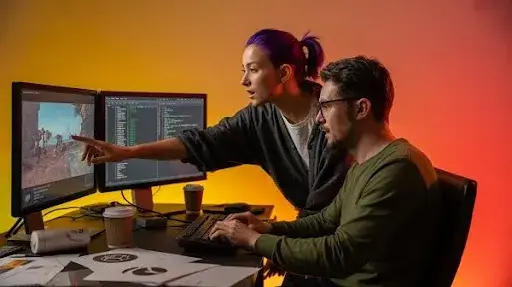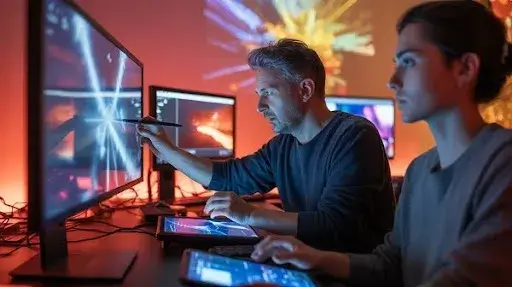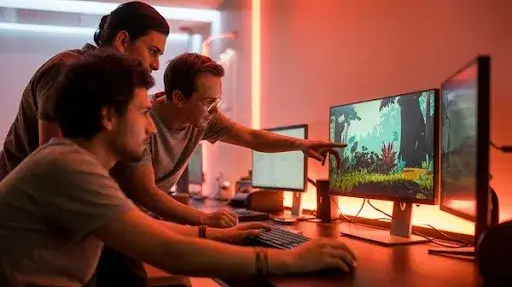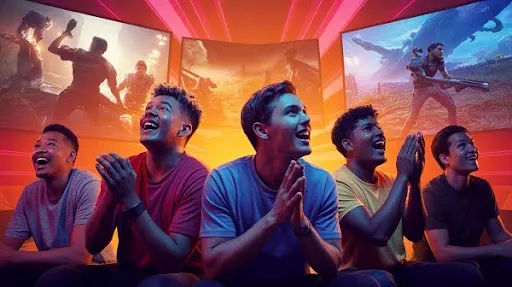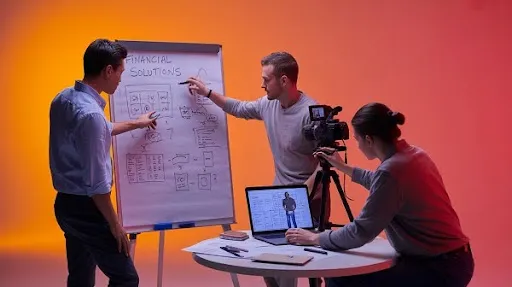Players judge with their eyes before they care about mechanics, stories, or controls. If a game’s visuals fall flat, they’re gone before the first click. That’s the power of VFX in games; it shapes the moment someone decides to keep playing or uninstall.
Studios know this, which is why visual effects aren’t an “add-on” anymore. They’re the spine of player experience, and entire teams now specialize in making pixels behave like physics, magic, explosions, smoke, impact, weather, or emotion.
So when people ask what is VFX in games, the real answer isn’t “effects that look cool.” It’s the design of feedback, atmosphere, motion, and clarity. It tells players what’s dangerous, what’s rewarding, and what’s worth paying attention to. It influences moment-to-moment choices without a single line of text.
And for studios like Prolific Studio, game VFX isn’t treated like a final polish. It’s baked into the early design process, built with real-time logic, and shaped around how people actually play.
Let’s break this down properly.
The Role of VFX for Gaming Today
Most people hear “game VFX” and think of explosions and magic spells. That’s a fraction of the job. VFX for gaming covers:
- Combat feedback
- UI clarity
- Environmental reactions
- Camera effects
- Texture-driven motion
- Mood and atmosphere
- Impact signals
- Weather and terrain reactions
It’s not built once and rendered. Games need everything to run in real-time, respond to action, and animate dynamically. That’s where real-time VFX separates itself from the film industry.
When someone swings an axe in an RPG, the dust kick, spark burst, and camera shake all come from micro VFX systems. When a player takes damage, it’s not just a health bar shrinking. It’s screen tinting, subtle glow loss, particles, or heat distortion.
That’s why ignoring VFX means ignoring gameplay clarity. Bad visuals don’t just look off; they break the experience.
Moreover, the VFX market is projected to increase from approximately $11.19 billion in 2025 to $20.29 billion by 2034. This means that it is not a facade but an actual global phenomenon that is here to stay.
Video Game Visual Effects Are More Than Eye Candy
Every second you spend in a game, VFX quietly guides the experience. It doesn’t ask for attention; it shapes it.
Think about:
- Footprints forming in snow
- Sparks bouncing from bullets
- Leaves blowing after a sprint
- Power charging animations
- Sudden muzzle flash
- Health pickups glowing just enough
These things don’t exist by default. Someone designed them. Someone shaped how long they last, how they react to light, how transparent or intense they should be, and how they affect performance. That’s game effects design in practice.
And this is exactly where a custom game animation company stands apart from template-based asset packs. One builds immersion. The other fills the empty space.
Real-Time VFX in Game Development
In film, visual effects are fully rendered and final. In games, everything happens live and must adapt on the fly. That means real-time VFX systems need to consider performance, hardware limits, timing, and input-based reactions.
A simple torch flame in a dungeon might involve:
- Particle systems
- Physics or noise functions
- Light flicker patterns
- Shadow projection
- Shader motion
- Ambient interaction
And it has to run on anything from a PlayStation to a mid-range laptop without tanking the frame rate.
This is where engines like Unity and Unreal Engine come in. They allow artists to test, tweak, and deploy effects live in-engine so designers don’t wait weeks to see results.
Engines and Tools Shaping Game VFX
Unity
Unity has earned a reputation for being flexible with stylistic effects. Mobile games, stylized action titles, and indie projects rely heavily on Unity’s VFX Graph. It lets artists connect behaviors visually instead of writing scripts.
Unity VFX supports:
- GPU-based particle systems in games
- Shader graph integration
- Motion-triggered reactions
- Custom materials and lighting logic
- Effects tied directly to animation events
It’s ideal when you want to scale across multiple platforms without losing quality.
Unreal Engine
Unreal Engine is known for impact and depth. Teams working with Unreal Engine VFX use Niagara for particle logic and Cascade for legacy support. The engine makes cinematic detail possible without pre-rendering.
Niagara supports:
- Smoke and fire effects in games
- Mesh-based particles
- Dynamic lighting in gaming
- Collision-based physics
- Volumetric fog
- Magic effects in games
And when paired with Lumen or Nanite, the visuals feel layered instead of pasted on.
Core Game VFX Techniques That Power Immersion
You can’t talk about game visuals without naming the actual tools and methods behind them. These are the core techniques driving most modern titles.
Particle Systems in Games
Particle systems are the base layer. They’re used for:
- Sparks
- Fire
- Dust
- Rain
- Debris
- Fog
- Energy bursts
- Aura effects
They simulate movement and dissolve quickly, keeping scenes dynamic. Particle count and lifespan control everything from realism to performance.
Game Shaders and Textures
Shaders decide how surfaces react to light, motion, impact, and transformation. Combined with textures, they power:
- Wet ground after rain
- Heat shimmer
- Lava glow
- Ice fracture
- Water ripple
- Skin translucency
Without shaders, everything looks flat and stiff. Without smart textures, everything feels cloned.
Dynamic Lighting in Gaming
You can’t fake atmosphere using static lights anymore. Modern engines use dynamic lighting to:
- Track fire flickers
- Respond to explosions
- Illuminate fog and smoke
- Reflect from armor
- Time-sync with weather cycles
Players feel the difference even if they don’t know why.
Environmental Effects in Games
Sometimes the environment is a character. VFX handles:
- Sandstorms
- Volcanic ash
- Ocean foam
- Cloud drift
- Snow layers
- Toxic gas
- Cave moisture
The point isn’t realism. It’s making the space react.
Cinematic VFX for Games
Cutscenes, intros, boss reveals, and camera-driven sequences use a hybrid of in-engine tools and scripted effects. It adds depth without stepping into full film production territory.
This is where visual storytelling in games amplifies emotional impact.
Special Effects in Video Games
Combat is where VFX gets judged fastest. Too much and it’s noise. Too little and hits feel hollow.
Game Explosions and Effects
Explosions aren’t one effect; they’re a stack:
- Core blast
- Secondary sparks
- Smoke trails
- Shockwave flash
- Debris particles
- Light pulse
- Ground scorch decal
When done right, explosions carry impact beyond a sound file.
Smoke and Fire Effects in Games
Nobody wants flat smoke. Realistic smoke has shape, lift, fade, rotation, and lighting. Combined with fire, it becomes a performance challenge. Teams use a mix of particles, shaders, alpha layers, and soft-body physics to make it believable.
Magic Effects in Games
Fantasy needs style. Spells use:
- Energy rings
- Impact bursts
- Aura trails
- Dissolve shaders
- Glyph animations
- Light distortion
Magic effects show creativity more than realism, which is why stylized particles and shader tricks are used more here.
The VFX Pipeline for Games
No two studios build VFX the same way, but the pipeline usually follows a familiar shape.
1. Concept and Reference
Artists pull visual references or build concept sheets outlining motion, shape language, scale, and use cases.
2. Prototyping
They build early versions in-engine with placeholder textures, particles, or shaders. This is where bottlenecks get caught.
3. Integration
Effects are connected to animations, audio, code events, or physics triggers.
4. Optimization
Particle counts drop, textures get compressed, shaders get simplified, and draw calls are reduced.
5. Testing
QA checks for frame drops, collision issues, overlap with UI, visual noise, and timing problems.
6. Polish
Extra sparks, lighting refinement, subtle trails, cleanup of fade timing, impact scale, and small edits that bring it to life.
A VFX artist for games isn’t just designing visuals. They’re planning, scripting, testing, and optimizing across engine constraints.
Interactive Visual Effects
Interactivity sets game VFX apart. When players trigger something, they expect a response immediately. No delay. No fade-in guesswork.
Common interactive visual effects include:
- Surfaces reacting to footsteps
- Power charge animations
- Bullet impact feedback
- UI hover effects
- Destructible objects
- Terrain deformation
- Reactive lighting
- Fog movement around the camera
This is what sells responsive design. It’s not just motion, it’s acknowledgment.
Realistic VFX Design vs Stylized Choices
Not every game is aiming for realism. Some use painterly effects, low-poly styles, neon palettes, cel-shading, or comic-style motion. Realistic VFX design focuses on physics-based accuracy. Stylized effects focus on clarity, contrast, and player experience.
Both rely on:
- Timed dissipation
- Layered systems
- Texture variation
- Shader tuning
- Performance limits
And both need to function without lag. Otherwise, the effect becomes a distraction instead of a signal.
Visual Immersion in Gaming
Great mechanics don’t matter if the screen feels dull. Visual immersion in gaming happens through layers of motion, feedback, and environmental behavior that make players forget they’re looking at assets. VFX carries that weight more than most design disciplines.
Players don’t consciously analyze what’s happening on-screen. They react to motion, impact, and atmosphere. A character running through a burnt-out city feels different when ashes swirl around them, lights flicker in broken windows, and dust shifts with footsteps. The effect is built, not accidental.
Immersion isn’t tied to realism. It’s tied to consistency. Stylized games still rely on environmental effects in games to anchor tone, from floating lantern embers to shifting fog to color-reactive terrain. That’s what separates intentional game VFX from visual noise.
Game Atmosphere Creation
A lot of people think of atmosphere as level design and lighting direction. VFX stitches those choices into something that feels alive. It supports atmosphere through reaction, motion, and scale.
Some of the most common elements used in game atmosphere creation include:
- Wind trails rippling across grass
- Snowfall affected by movement
- Sand movement after impact
- Dripping moisture in caverns
- Light haze at distance
- Pollen drift in forests
These aren’t filler effects. They’re signals. They tell the player how a space feels and how motion interacts with it. They also reinforce time of day, heat, cold, tension, and silence.
Cinematic VFX for games often kicks in during transitions, boss intros, or zone changes. Instead of static fades, visual artists use lens blur, directional particles, bloom pulses, or atmospheric fog to connect scenes. It keeps players grounded in the space instead of jolting between segments.
The Link Between Gameplay and Visual Feedback
Nothing kills impact faster than a hit that feels empty. Visual feedback drives every swing, shot, cast, or collision. Combat VFX doesn’t just add flash; it communicates damage, timing, and reaction.
Here’s how video game visual effects support gameplay clarity:
- Color shift to mark danger range
- Sparks or distortion on parries
- Ground-slam shockwaves with area boundaries
- Enemy glow when staggered
- Impact pause linked to camera shake
- Tracers following projectiles
- Damage pulses through UI effects
Real-time VFX ties everything to input speed. Players expect zero delay. A missed hit should feel different from a clean strike, and a critical attack needs its own visual signature. That’s how habits form and players adapt to difficulty.
Interactive Visual Effects and Player Response
Players don’t want animations that happen in the background. They want response. Interactive visual effects handle that direct feedback.
Examples include:
- Bullet holes on walls
- Sparks from clashing weapons
- Dynamic footprints in different terrains
- Brush reacting to character motion
- Liquids rippling around movement
- UI ripple when a button is tapped
- Energy buildup before ability use
These responses don’t just add polish; they guide decision-making. A lot of timing-based combat relies on tiny VFX cues that signal opportunity or threat without interrupting the experience.
The Cost of Ignoring Real-Time Systems
Static effects in a live game environment don’t stay unnoticed; they look wrong. Real-time VFX isn’t an aesthetic choice. It’s a system requirement.
Effects need to:
- Scale across platforms
- React to physics
- Run at stable frame rates
- Respond to lighting direction
- Change based on input and camera
- Tie into shaders and particle logic
Studios that ignore real-time behavior end up with effects that pop in, disappear awkwardly, or stay locked in place while characters and lighting move around them. That disconnect breaks immersion faster than low-quality textures.
Frequently Asked Questions
Final Words
Most players can’t explain why something feels satisfying, but they can tell when it doesn’t. That’s why VFX isn’t surface art. It’s a design system with visual intent.
Prolific Studio treats game effects as part of gameplay, not a gloss coat. The team builds real-time logic, optimizes for hardware, shapes identity through motion, and connects visuals to action. That’s how games earn reactions instead of scroll-past glances.
If you’re building something that needs to feel alive, responsive, and visually grounded, this is where it starts, with VFX that responds like it was always part of the game.
Related Articles:



